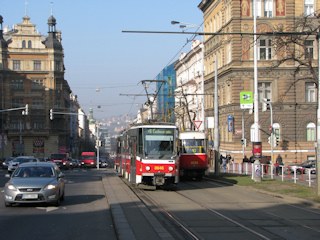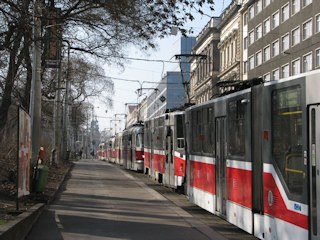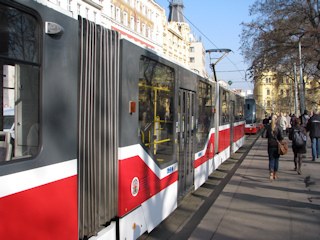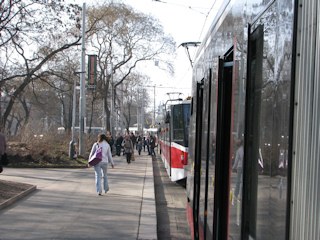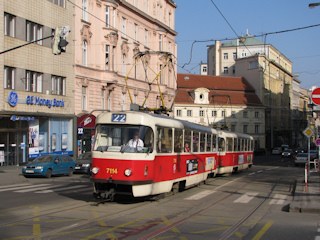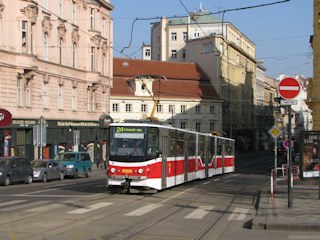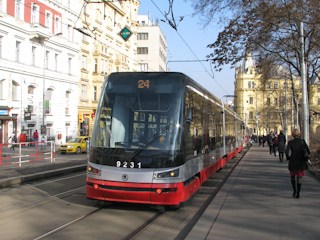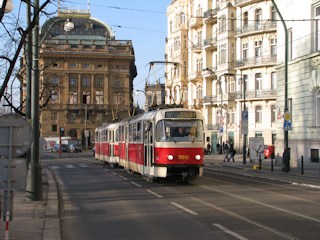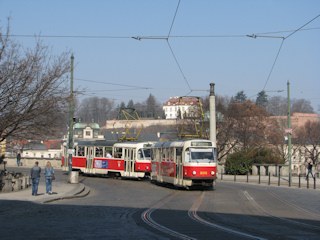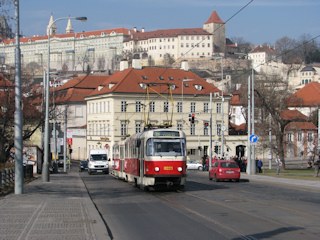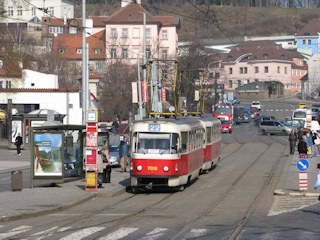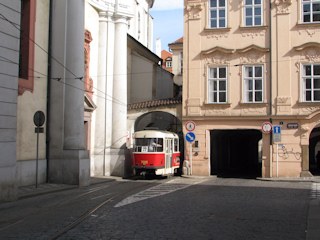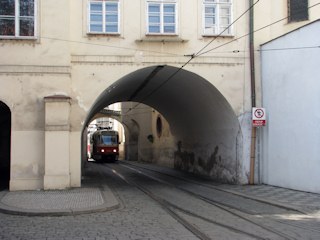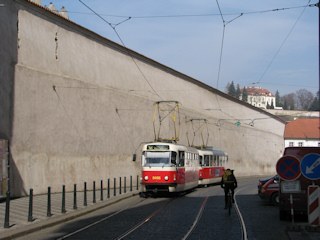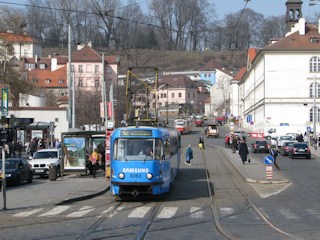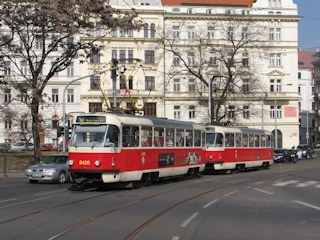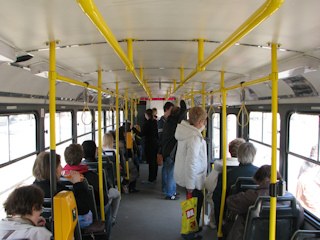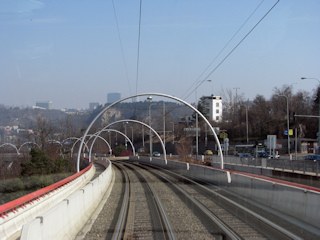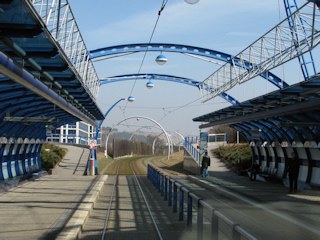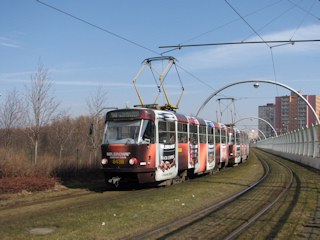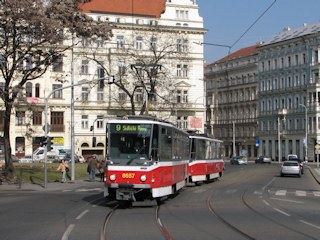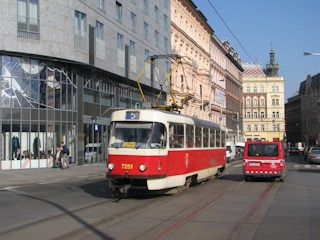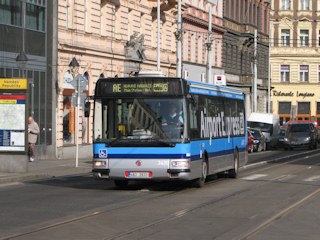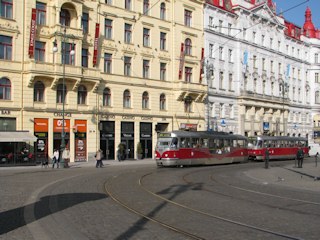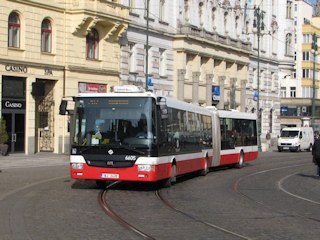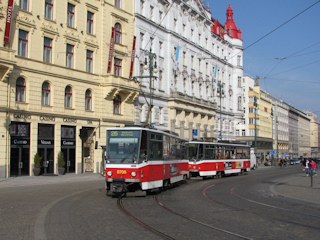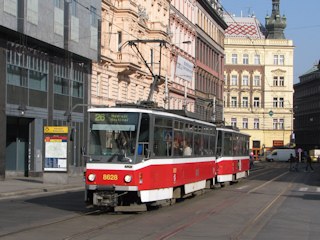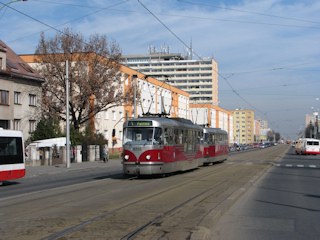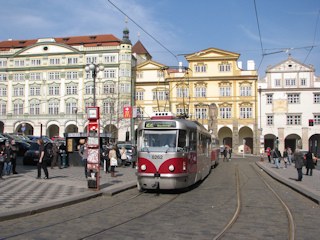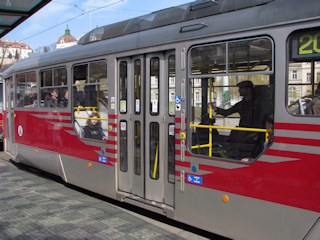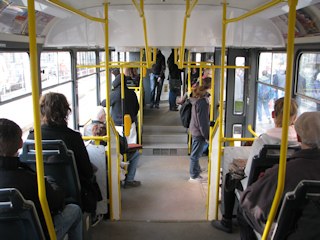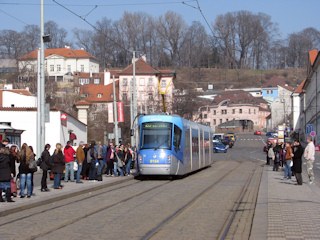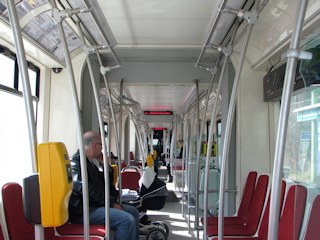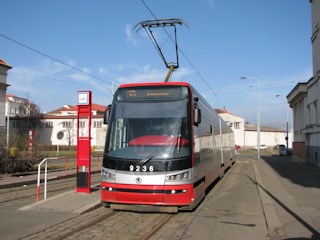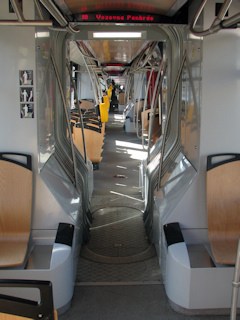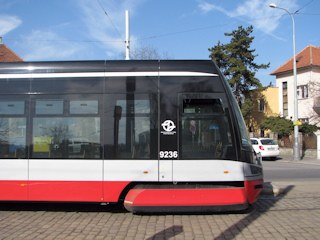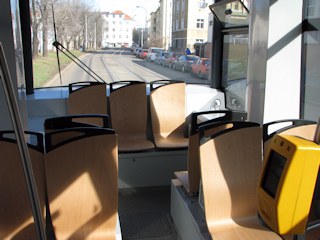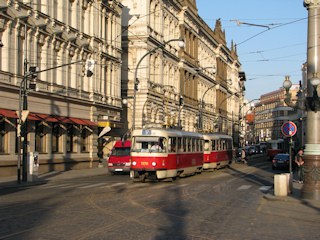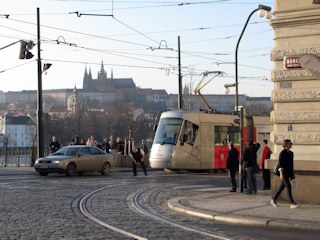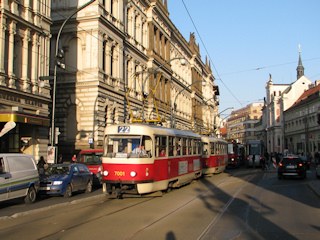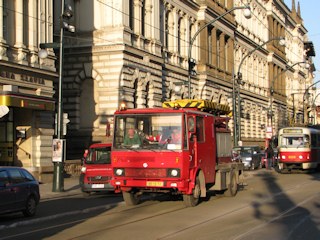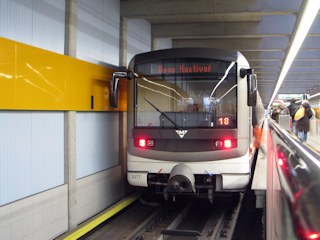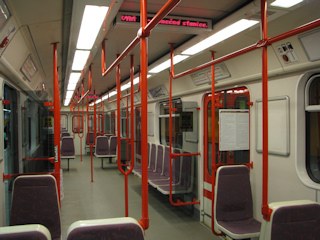budapest
other hungarian
close-up
lost rails
other countries
Prague, March 2012
Hier geht's zur deutschsprachigen Version / Kattints ide a magyar változathoz
The last time I've visited the Czech capital was in 2002, so it was high time to go back again. It was more of a romantic tourist trip this time, but my girlfriend agreeded to do a little tramspotting here and there on the way :)
To the left you can see our first glimpse of trams in the morning near metro station I. P. Pavlova, to the right you can see a queue-up about 5-6 minutes later at Karlovo náměstí. I believe someone has parked his/her car on the tracks, which resulted in a spontaneous tram parade.
The people seemed to be surprisingly relaxed about the event - you would've heard more angry words in Budapest in a similar case :)
A video with public transit scenes from
Prague:
0:02- The end of the "tram jam" at Karlovo
náměstí
0:13- Mánesův most with a Tatra
T3R.P double-set
0:21- M1-class train on metro line "C"
0:29- 81-71M-class train on metro line
"A"
0:36- Škoda 15T tram negotiating a 90-degree
left turn
0:50- Tatra KT8D5.RN2P (a KT8D5 retrofitted
with a low-floor middle section) crossing Wenceslas square
0:59- Modernised T3 on the line to Barrandov.
We'll see more about this soon.
1:13- Škoda 14T (being a bit loud) at Národní
třída
1:26- On board of a T6A5
1:39- A nice bend near the metro station Strašnická
1:51- T6A5 double-set at the same location,
coming from the other direction. I wonder why it approached the stop so
slowly... Okay, it's steep, but such slowness is not typical for Prague
trams...
2:07- The same location again, with another
view at the bend
2:19- An 81-71M train leaving the Muzeum stop of metro line "A"
But back to Karlovo náměstí - two generations of Tatra trams: a classic PCC (complete with PCC accelerator) T3SUCS double-set to the left, and an articulated KT8D5.RN2P with retrofitted low-floor middle section to the right.
To the left: a Škoda 15T. To the right: T3R.P (modernised classic T3) double-set on Masarykovo nábřeží.
Tatra T3 still rule the streets of Prague. Of course the cars we see today are not as old as the type - introduced in 1960 - itself: the T3R.P are original T3 from the 1960s and 70s modernised around 2006, while the T3SU and T3SUCS were built in the 1980, although still with PCC accelerators.
To the left: Náměstí Jana Palacha with a T3R.P double-set. To the right: another similar unit about 200 meters away, on Mánesův most.
A few hundred meters more, and we arrive to the busy junction Malostranská. To the right we see a T3R.P double-set underneath the Prague Castle, to the right it's another double-set, consisting of two T3SU. The most strinking difference from the outside is that the T3SU/SUCS still sports the old route/destination slates, while the R.P has matrix dot displays.
A video of the various T3 models in Letenská, at Náměstí Republiky, at Malostranská, at Malostranské náměstí and at Sídliště Petřiny.
In Letenská, really close to Malostranské náměstí there's this gauntleted "bottleneck", which I could not photograph last time, because trams weren't running.
To the left: a T3R.P double-set at the back wall of Valdštejnská zahrada. To the right: Malostranská again, with lots of "tubby Tatras".
To the left: T3R.P's at Náměstí Kinských, to the right: the interior of one such car (unless I've mixed up the photos).
The spectacular light-rail-like tramway to the housing area Barrandov - which is located on a plateau - was opened in 2003, so I had to go there, too!
As far as architecture is concerned, I find the stretch Hlubočepy - Barrandov a bit "over-designed" (first and foremost because of the stations like space stations - see "Battlestar K Barrandovu":), but boy would I be glad to see such lines being built in Budapest!
A cross-section of a ride on this line. The descent via the viaduct from the plateau to Hlubočepy is really spectacular!
To the left: a T3R.P double-set in "shrink-wrap" advertising arrives to Sídliště Barrandov. To the right: Náměstí Kinských again, this time with a T6A5 double-set.
T3SUCS running in solo (left) and an airport bus (right) at Masarykovo nádraží.
Náměstí Republiky could have been a magnificent photo spot, but somehow most of the photos were spoilt by people and bikes running into the picture :) Here's a selection without such annoyances: a T3R.PLF + T3R.P unit to the left, an articulated bus to the right.
And two T6A5 double-sets again. In a strange way these were my favorite trams during the visit: they're not as spartan as the plain old T3's, they seem to be quite dynamic, and they resemble "our" Tatras a bit ;)
Prague has started to acquire low-floor vehicles recently. We already saw the KT8D5.RN2P, here are more variations on partially or fully low-floor trams :
T3R.PLF - basically a newly built T3, length-wise stretched a little bit, with a low-floor section at the middle door.
Allegedly they only take the bogies of original T3's when building these cars - I find it quite strange to build vehicles first build in 1960, in the 21st century. And its livery is also very 1950s. Okay, maybe it's just that I'm not a huge fan of the T3...
Parallel to the low-floor "stretch"-T3 they also ordered a batch of Škoda 14T articulated trams. Not a real winner either, and DPHMP - the transit operator - probably thought the same, and instead of getting more of this, they ordered a new type:
... the Škoda 15T "ForCity". This tram features four bogies that are connected to the three body sections in two different ways: the bogies at the front and back have their pivoting point closer to the middle, making them sweep out strikingly (i.e. in a larger angle than with the pivoting point located in the geometrical middle of the bogie). The two inner bogies are pivoting around their centres, but the body sections are connected to them eccentrically, with the pivoting point being somewhere between them (as opposed to most classic artiulated bogie trams where the joint of the body sections and the pivoting point concur). To the left: a 15T at Vozovna Pankrác, to the right: the "tunnel" above one of the middle bogies.
15T's seen in the inner city, inside and outside.
The end section of a 15T to the left, the seat layout in there to the right - the bogie has room to move (pivot/sweep) around beneath the bulky mouldings .
Seeing Prague through the window of a 15T. It was pretty bouncy in the crossing between 0:06 and 0:11 :)
A working day's afternoon rush-hour
The sun goes down early in March, and even when it's still up, it shines from a low angle, but I just had to take photos of the massive traffic going and leaving Národní at the banks of the river Vltava. Trams queing from every direction, with usually more than just one crossing at every green light... it was nice! One of the eletrically-operated points however seemed to be broken - the drivers had to set them manually (as seen to the right).
In the queue (to the left) stood this rubber-tyred tower car (to the right) looking like a cross between a Škoda/LIAZ truck (which it probably was) and a Karosa bus.
If you live in Budapest, you always compare it to two other cities: Vienna and Prague, being the other capitals in the former K.u.K.-Monarchy. If you compare the metros of these cities, Budapest clearly loses. For example, even though Prague also uses ex-Soviet metro trains, they rebuilt and modernised them heavily. On the photos above you can see a class 81-71M train from the outside and inside.
Nightly tram scenes in Prague's inner city, featuring different models of the classic Tatra T3, a T6B5, and some Škoda 14T/15T.
And that was it, I hope you like this travelogue!
Back to the top Back to the main page
